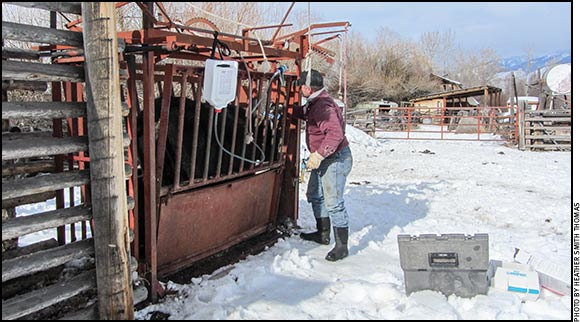
Precalving Vaccination Programs
for Cows
Timing is important for efficacy of vaccines.
The best protection against disease in newborn calves is making sure they get an adequate amount of good-quality colostrum, containing antibodies against most of the pathogens they may encounter, soon after birth. If the dam has a chance to build a high level of antibodies before calving, she passes this temporary immunity to her calf via colostrum.
Vaccinating cows ahead of calving can help build peak antibody levels to make sure the cows’ colostrum contains the maximum amount of protective antibodies. Eugene Janzen, professor of production animal health at the University of Calgary, says the E. coli vaccines work well, but may not be as necessary as they have been in the past, especially in herds that no longer calve in confined or contaminated areas.
“Viral fractions of precalving vaccines, such as the rotavirus and coronaviruses, may not perform as well, and timing is much more critical. If calves will be at high risk between 2 to 4 weeks of age for viral infections, make sure there will be enough antibodies in the colostrum to help them at that time,” he says. The cow needs peak antibody levels when she calves.
“With those particular viruses, if you boost the cow’s immunity, those antibody levels rise fairly quickly and are deposited in the colostrum fairly quickly; but they also wane quickly. If you vaccinate cows in early February and the majority of your calves arrive the end of March or later, the efficacy of that vaccine will be compromised,” he says.
You’d need to vaccinate the cows closer to when the calves will be at risk, or give the cow a booster closer to that time.
It helps if your calving period is short. “If calving is strung out, and especially if it’s behind the barn rather than out on clean pasture, we encourage ranchers to vaccinate late-calvers again,” explains Janzen. Different vaccine formulations have different lengths of time in which they are effective, so discuss your calving situation with your veterinarian and select the vaccines that best fit your program.
Some products need a two-shot series the first year, and an annual booster thereafter. Make a plan in consultation with your veterinarian regarding what product to use and when, depending on when it is feasible to have the cows accessible for vaccinating.
Some cases of diarrhea are due to protozoal infections such as cryptosporidiosis or coccidiosis.
“There are no vaccines for these infections, he says. “The best prevention is a clean pasture with cattle spread out and not crowded,” he says.
If a calf gets sick, he sheds many times more pathogens than what might be in the cow’s feces.
“Sick calves greatly amplify the infectious pressure. Having clean ground at calving is still the best advice for preventing disease in young calves,” Janzen says. Prevention depends a lot more on good management and clean calving areas than from a vaccine bottle.
“We encourage ranchers to vaccinate cows for clostridial organisms, especially perfringens, since perfringens may be to blame for the various enterotoxemias — even though these may be hard to diagnose in the lab. At least this particular vaccine is relatively inexpensive, so we vaccinate in case it might help,” says Janzen.
“There are many vaccines with many label claims, and we often make assumptions. The E. coli vaccines work so well that we tend to think that everything else should work in a similar fashion, but it’s not that simple. Most of the time we don’t know with certainty what ‘bugs’ we are dealing with, and we just play the odds,” he says.
Herds with scour problems can often reduce sickness by strategic vaccination of the cow herd, however, particularly if efforts are made to also improve the calving environment and lower the risks for exposure to overwhelming pathogen loads.

Editor’s Note: Heather Smith Thomas is a freelance writer and cattlewoman from Salmon, Idaho.






